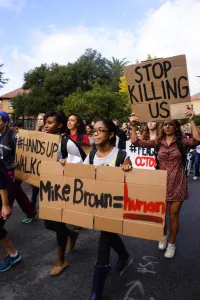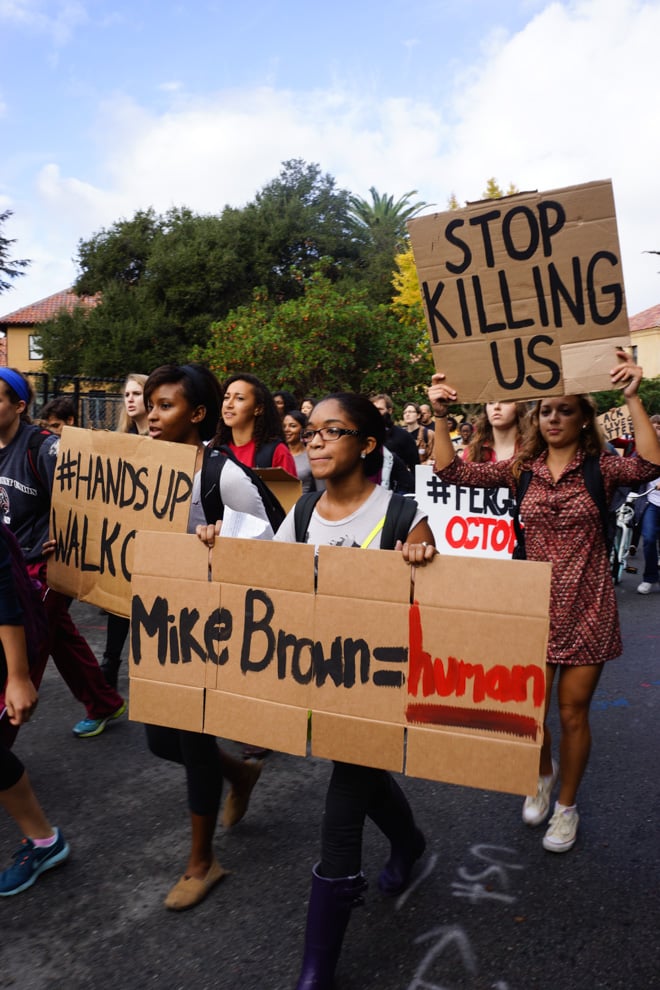
Winter break did not put a freeze on #BlackLivesMatter protests for Stanford students who returned home for the holidays. In fact several students across the nation, from Brooklyn, New York, to Denver, Colorado, joined protests that honored the local victims of police killings and called for justice and the valuing of black lives.
On New Year’s Day, Colin Kincaid ’17 attended a peaceful die-in at Wheaton Mall in Silver Springs, Maryland. Organized by a high school student and college student, the protest put a twist on the #BlackLivesMatter slogan by changing it to #BlackLivesStillMatter to mark the new year and that “the movement against systemic racism is not going away,” according to Kincaid.
“The protest as a whole impressed me, as the organizers put it together in less than a week [which is] a testament to the power of grassroots organizing and the effectiveness of the young, black women leading this movement,” Kincaid said..
Further north in the Big Apple, one Stanford student was impressed by the solidarity shown by the pan-Asian community for the #BlackLivesMatter movement. Nisrin Abdelrahman, an anthropology PhD candidate, participated in a protest in East New York organized by the family of a black father killed by a policeman.
The protest, led by the 2-year-old daughter and family of the victim, highlighted the killing of a local father who was shot in the staircase of his building by an NYPD officer and concluded with the reading of an open letter by the victim’s family member to the precinct.
From feelings of solidarity to discomfort, many students had lingering emotions after participating in their local peaceful protests.
After hearing a speech by Erika Totten, an activist from Ferguson, Missouri, speak on police brutality and her personal experience as a mother and activist, Kincaid was “moved [to tears]” by her words.
Abdelrahman had a slightly different emotional response while protesting due to her own personal experience with police brutality. After seeing members of the pan-Asian community come out in support of the protest, she experienced a new-found sense of comfort from this sign of solidarity.
“I felt a sense of strength and hope for the first time since my own partner had been framed by a police officer earlier this year,” Abdelrahman said. “Our own experience with the court system and the injustice and violence it inflicts on countless families was isolating and paralyzing. Marching for justice for Akai Gurley and countless others that day was therefore a powerful experience for me.”
For ASSU Senator Rachel Samuels ’17, the shift in setting from Stanford to Denver caused her to feel less connected to the protest as she found herself among unfamiliar faces.
“It was a much different experience to be surrounded by those I did not know, and whose views and reasons seemed much less discernible than those of my peers on campus,” Samuels said. “While Stanford students also hold a spectrum of views, I felt more empowered saying ‘This is what democracy looks like’ [on campus] in contrast to marching behind an upside-down American flag like I did in Denver.”
To Samuels, the difference between the protests at home and those at the Farm was the perspective offered by the protesters.
“I want to respect perspectives against unjust systems and I would also like a perspective of empowerment for changing systems to be represented, which I felt was more prevalent at Stanford,” Samuels added.
Despite the biting cold and her white identity, Sarah Gleberman ’15 was not deterred from attending a protest centered around the black community.
“It was a powerful experience to see so many people from different backgrounds together supporting one cause,” Gleberman said. “As a white person, I was mostly trying to just be there and be a part of the protest…so I didn’t start any chants or anything, just followed along with the ones around me.”
Natasha Patel ’16 felt like the protest she attended in the Freedom Plaza in Washington, D.C., was more of a publicity event than a protest.
“It was a strange experience to be a part of,” Patel said. “It was supposed to be an organized public protest with reverend Al Sharpton at the front, but it felt more like an event because of the series of speakers and the VIP section.”
While some students joined in chants shouting “No racist…police!,” one student who has familial ties to the NYPD felt uneasy at the protest she attended.
Gleberman believes that changes within law enforcement need to happen but that police officers should not bear the brunt of the protestors’ ire.
“Some of the chants made me deeply uncomfortable, particularly the ones that targeted police officers in [Silver Springs, Maryland],” Gleberman said. “Anger toward the legislators who allow and encourage military-style weapons and training for police officers is certainly warranted; however, I felt that there was a strong and even violent current of anger towards all police officers as people.”
“I believe that police officers can and should be valuable community members who help keep their towns and cities safe,” Gleberman added. “I believe ‘these racist cops have got to go’ is over-simplifying a complex issue and projecting the problems with police training into the personal ideology of every police officer.”
While students involvement in the protest invoked their criticism of the #BlackLivesMatter movement, some expressed optimism in the movement’s effectiveness and success.
“My hope is that as this movement for justice grows, it will continue to be led by those most affected by police and court violence because they know best how these systemic forms of violence affect people’s day to day lives in ways that police cameras and other quick fix solutions can never address,” Abdelrahman said.
Contact Chelsey Sveinsson at svein ‘at’ stanford.edu.
